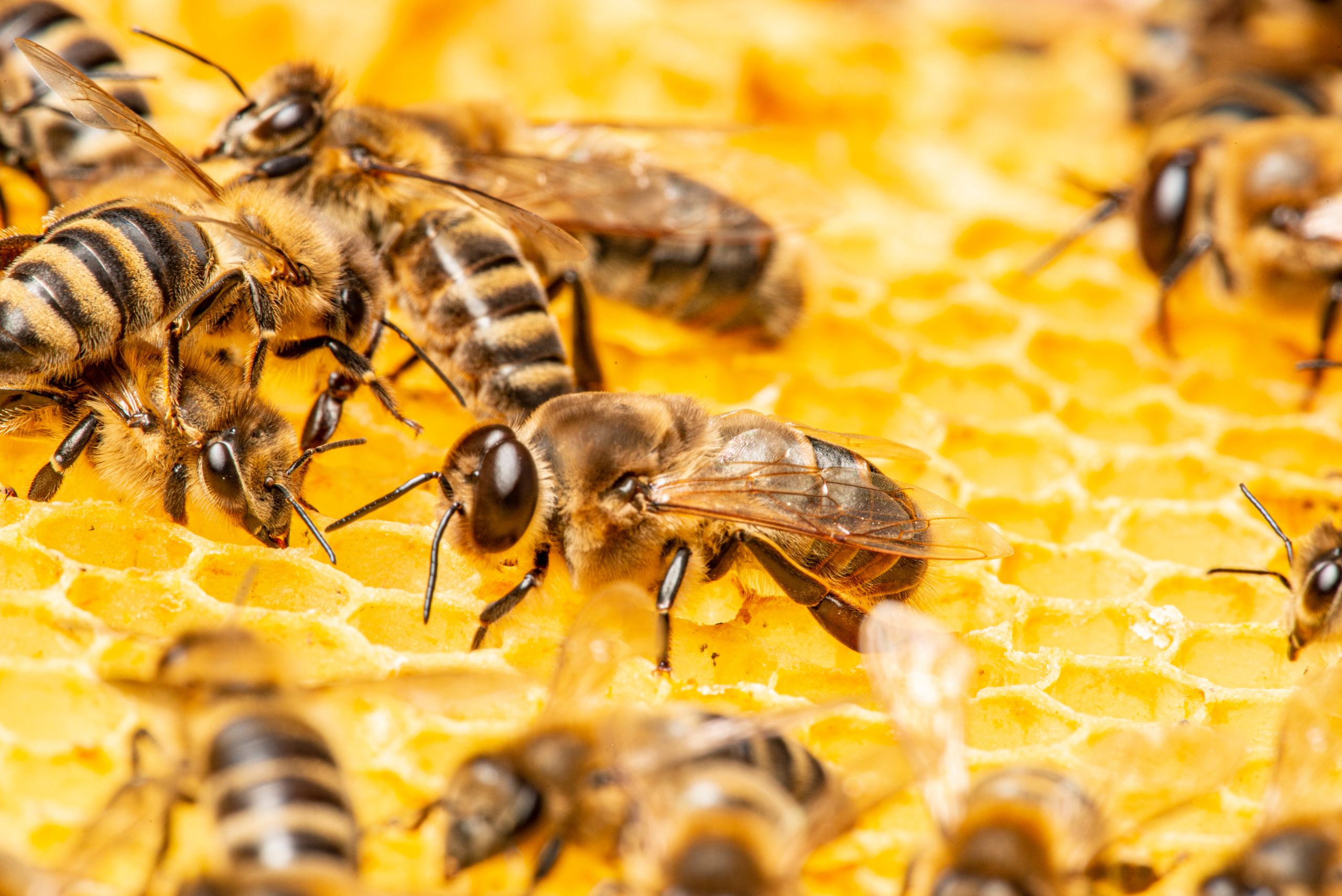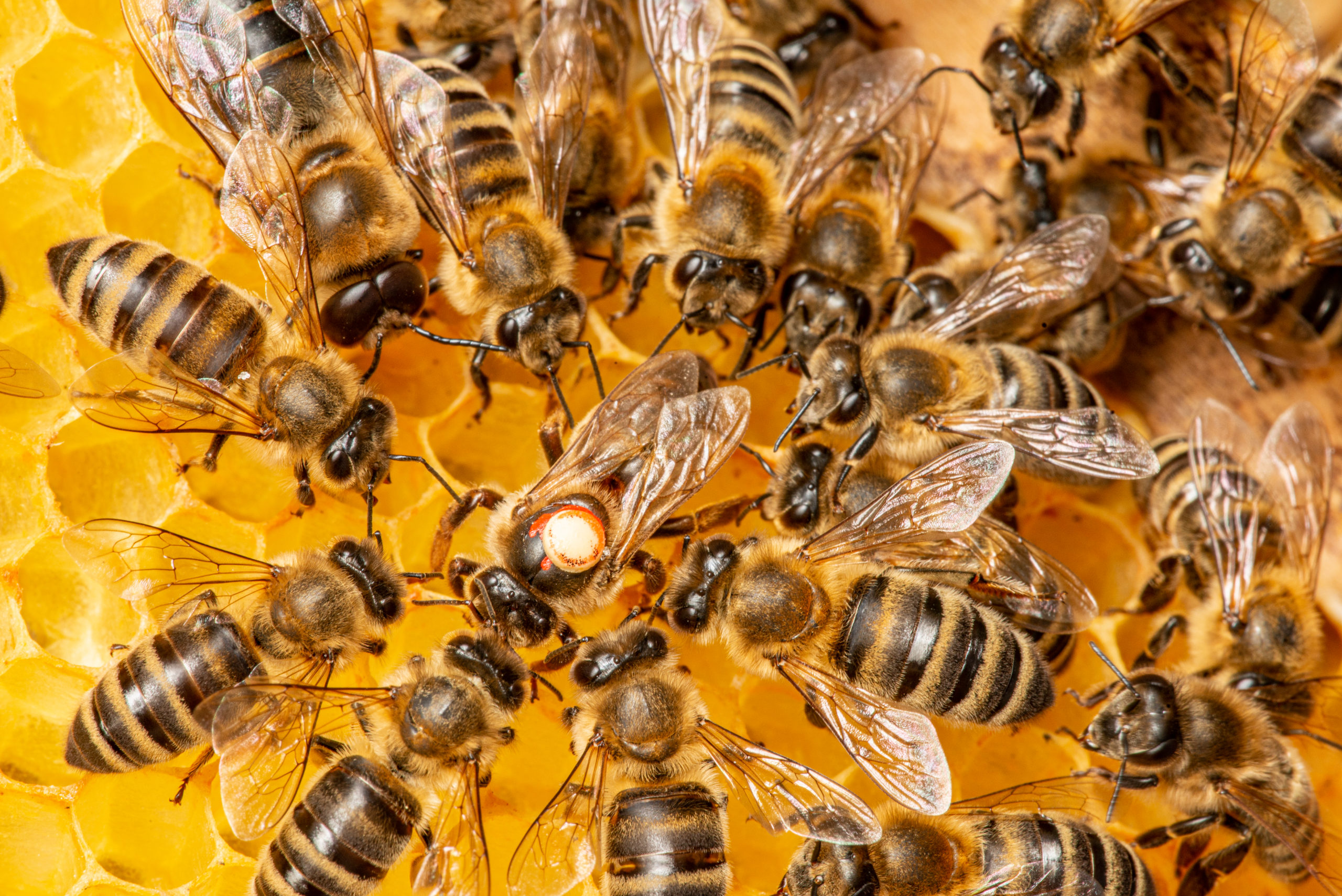Bee Buddies: Comparing Honeybees and Bumblebees
Bee Buddies: Comparing Honeybees and Bumblebees
It has been reiterated time and again in the environmental media world that bees are our friends, not our enemies. The main reason for this movement is that the pollinating and nectar-gathering that bees do are essential to the survival of plants everywhere. Every bee does this to some extent, but some are definitely more helpful than others. The honeybee and bumblebee are likely the two that come to mind for the majority of us when we think of pollinating bees. But since they seem to help the ecosystem in the same way, how similar are they really? Let’s take a closer look at each bee’s core characteristics before diving into their limited similarities.
Honeybees – The Mass Producers

Appearance: Thin and smaller; black stripes; 2 sets of wings; could be mistaken for wasps
Habitat: Hive above ground; crafted wax honeycombs as individual cells within the hive
Queen Bee: Only job is to reproduce and lay eggs; can survive for years in same hive
This bee is probably the most common and the one you often see buzzing around your backyard every spring. This is because honeybee colonies number in the tens of thousands, usually spiking at about 50,000! The colony can live for years, thanks to their cozy hives that provide shelter for proper hibernation every winter. The honeybee is a eusocial bee, meaning that it lives in large colonies with one female bee (the queen) who mates and produces offspring while the rest of the colony takes care of the eggs and young. The worker bees are all sterile females and the drones are male honeybees whose sole purpose is to mate with the queen.
Honeybees live to gather nectar and pollen, and they will go to as many areas as possible to achieve those goals. They are effective communicators with each other through shaking their bodies to indicate the direction of a great source of nectar for the workers to go and gather. Honeybees will even go so far as to leave their current nectar-foraging site for a new one if it’s enticing enough. This means that they aren’t the most thorough pollinators out there, often favoring quantity over quality. But since there’s so many worker honeybees, it’s safe to say that they are still incredibly helpful to plant life.
The honey that we enjoy on freshly-baked biscuits or drizzled in our tea comes from these beneficial bees. They store a lot of nectar in the hive, where most of it will go towards providing food for the queen and her loyal offspring. They dehydrate this nectar to make honey, which is in such abundance that larger creatures (including humans and Winnie the Pooh) have been able to take some for us without starving the hardworking bees.
As for modern beekeepers and growers, honeybees seem to be the best for helping plants in modern times. This is not only because they are so productive in finding many nectar sources at once, but also because honeybee colonies are much easier to transport than bumblebee colonies. Unfortunately, honeybees also die right after stinging a person since their stinger comes out, but this isn’t a super frequent occurrence if the bees are left alone to do their jobs.
Bumblebees – The Fuzzy Pollinators

Appearance: Round and fuzzy; black and yellow stripes; large
Habitat: Nest in a sheltered location; usually in old rodent nests, bird houses, wood, in-ground
Queen Bee: Sole survivor through winter and makes new home in spring; lays eggs immediately after finding the new home
Bumblebees are the more cartoonish and eye-appealing of the two bees, with their round bodies and fuzzy texture. Their colony is relatively small, averaging about 250 bees. The colony essentially starts over every spring because every worker bee dies before winter, leaving the queen to start a new nest and colony every time. They are much more intentional with their nectar-gathering, often staying at one flower to get every drop that they can before moving on.
As mentioned before, bumblebees help pollinate flowers as they collect nectar from them. They do this by brushing against the pollen of one flower and then transferring it to the next flower they visit. This process is essential for the plant because it allows them to reproduce and create more seeds. Because of their fuzzy bodies, bumblebees pollinate without trying since so much pollen collects on their fuzz. Although bumblebees gather nectar like honeybees do, they don’t make honey out of it. The gathered nectar is just enough to sustain the small colony, since everyone except the queen will die off before winter.
In addition to their fuzzy bodies, bumblebees are effective pollinators for a few other reasons. Their tongues are pretty long for a small bee, which allows them to have a wider variety of flowers to choose from. They can reach the nectar in the taller types of flowers that honeybees can’t. Also, their larger size lets them carry more pollen and nectar than smaller pollinators. This is why we see so many large bumblebees covered in yellow powder!
When people talk about the bees being endangered, the conversation usually turns to bumblebees. But in reality, honeybees are more at risk than bumblebees. Bumblebees are still doing pretty well every year and pollinate our plants with ease. A large reason for their extended survival skills is the location of their nests. Since they’re usually so hidden and expire at the end of the year, bumblebees can evade extinction if they’re careful. Also, beekeepers who raise bumblebees are committed to keeping the population afloat. Whatever the main reason, bumblebees are definitely beneficial bees that are one of the most adorable of the general insect population.
The Same but Different

Now that we’ve established the basics of each type of bee, let’s talk about the main similarities between the two. There are more differences between honeybees and bumblebees when we take the closer look that we just did, so this is not a very extensive section.
The first is that both bees live in a colony with a queen bee. Bees as a species are primarily eusocial, meaning they only live in a shared environment and live to provide for their queen(s) and fellow bees. Although the specifics of these queens differ, they both have the same primary purpose: reproducing. Since queens are the only female bees that can reproduce, they need to consistently lay eggs to keep the colony going strong. In both bee colonies, the queen will mate and then hibernate throughout winter in order to reproduce closer to spring for the next generation to survive. The queen bumblebee is the only bumblebee that survives winter, but they are very similar to honeybees otherwise.
Another main similarity is that both will sting when provoked. Bees are pretty docile by nature, and they don’t actively seek out people to sting despite what cartoons have led us to believe. But if their home, queen, fellow bees, or their own life is threatened, both bumblebees and honeybees will break out the stinger. But, as mentioned earlier, there is a key difference between the two bees in the outcomes of their stings. Honeybees die right after stinging someone, but bumblebees survive and can sting more than once. This is because honeybees lose their stinger after using it and bumblebees don’t. But bumblebees don’t swarm as a group, while honeybees will if the threat is on their home turf. Regardless it’s important to never disturb a bee hive or nest if you find one in the backyard. Professional pest control technicians have the training and equipment to remove even the toughest of nests without harming anyone, “bee” it honeybees or bumblebees.
You Won’t Bee-lieve What Pest Control Can Do!
Bees are essential to the healthy lives of our flora and fauna, and they should not be completely removed from the world. But that doesn’t mean that having a hive of honeybees or burrow of bumblebees in your yard is an ideal situation. It can become a safety hazard if someone in your family is allergic to bee stings; plus, no one wants to accidentally run into a hive and get stung, anyway. Our experienced technicians know how to efficiently remove bee hives, and bees in general, from yards without the use of harmful chemicals. Contact us today to learn more about how we can prevent your yard from becoming an inadvertent bee sanctuary.
Citations
Anderson, C. (2021, December 20). Honey bees vs bumble bees: {alike & different}. Carolina Honeybees. Available at (Accessed on July 11, 2022, from https://carolinahoneybees.com/honey-bees-vs-bumble-bees/
Bumblebees vs. honeybees: What’s the difference, and why does it matter?. (n.d.). Student Conservation Association. Retrieved July 11, 2022, from https://www.thesca.org/connect/blog/bumblebees-vs-honeybees-what%E2%80%99s-difference-and-why-does-it-matter#
Gilbertson, A. (n.d.). Bumblebee vs honeybee: Understanding the differences between the two most common bees. Butterfly bee garden. Available at https://butterflybeegarden.com/bumblebee-vs-honeybee/ (Accessed on July 11, 2022).
Kearney, H. (2019, September 3). Comparing bumblebees with honeybees. Keeping Backyard Bees. Available at https://www.keepingbackyardbees.com/comparing-bumble-bees-with-honey-bees-zbwz1909zsau/ (Accessed on July 11, 2022).
8 Creative Ways to Have a Pest-Free Fourth of July
8 Creative Ways to Have a Pest-Free Fourth of July 8 Creative Ways to Have a Pest-Free Fourth of July Summary: The Fourth [...]
A Simple Guide to Preventing Stinging Pests
A Simple Guide to Preventing Stinging Pests A Simple Guide to Preventing Stinging Pests Summary: Stinging insects are more active in warm weather, [...]
These 10 Natural Mosquito Repellents Can Actually Help
These 10 Natural Mosquito Repellents Can Actually Help These 10 Natural Mosquito Repellents Can Actually Help Summary: Natural mosquito repellents are easier to [...]
How to Get Rid of Carpet Beetles
How to Get Rid of Carpet Beetles How to Get Rid of Carpet Beetles Summary: Carpet beetles are sneaky pests that don’t usually [...]
How Do Roaches Affect Asthma and Allergies?
How Do Roaches Affect Asthma and Allergies? How Do Roaches Affect Asthma and Allergies? Summary: It’s no secret that pests impact human health, [...]
These 5 Carnivorous Pests Might Surprise You!
These 5 Carnivorous Pests Might Surprise You! These 5 Carnivorous Pests Might Surprise You! Summary: There are many eco-friendly ways to prevent pests, [...]

